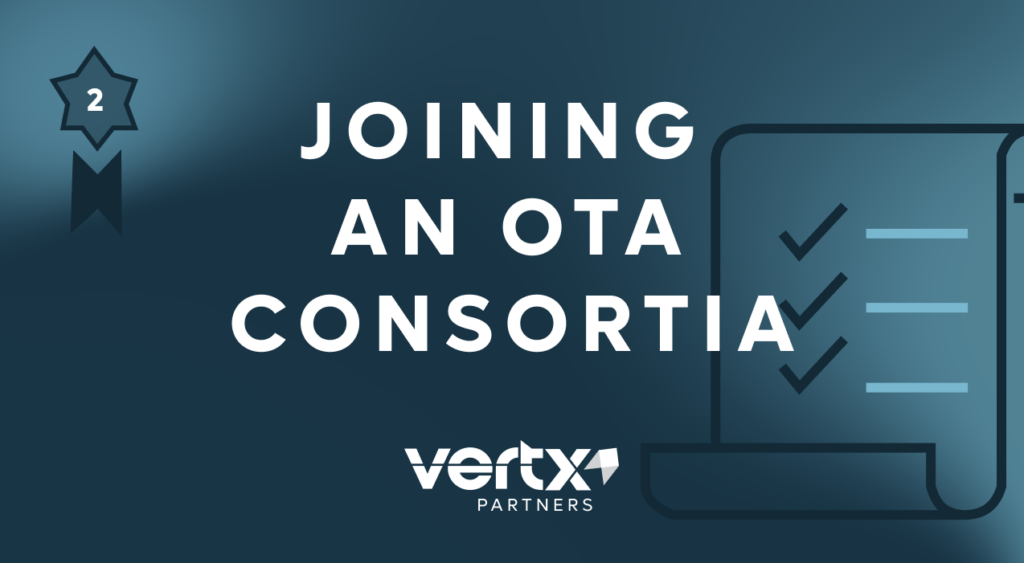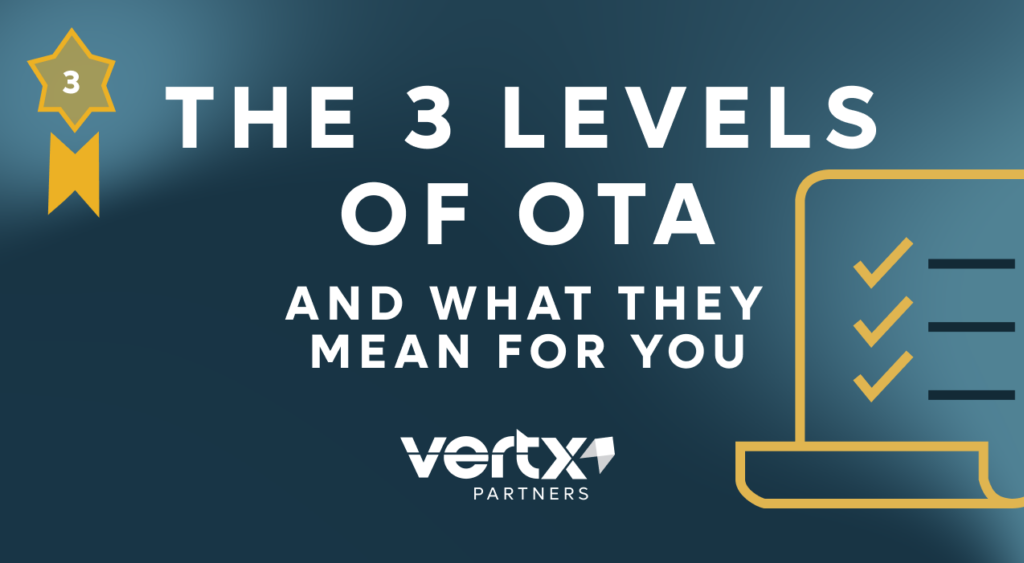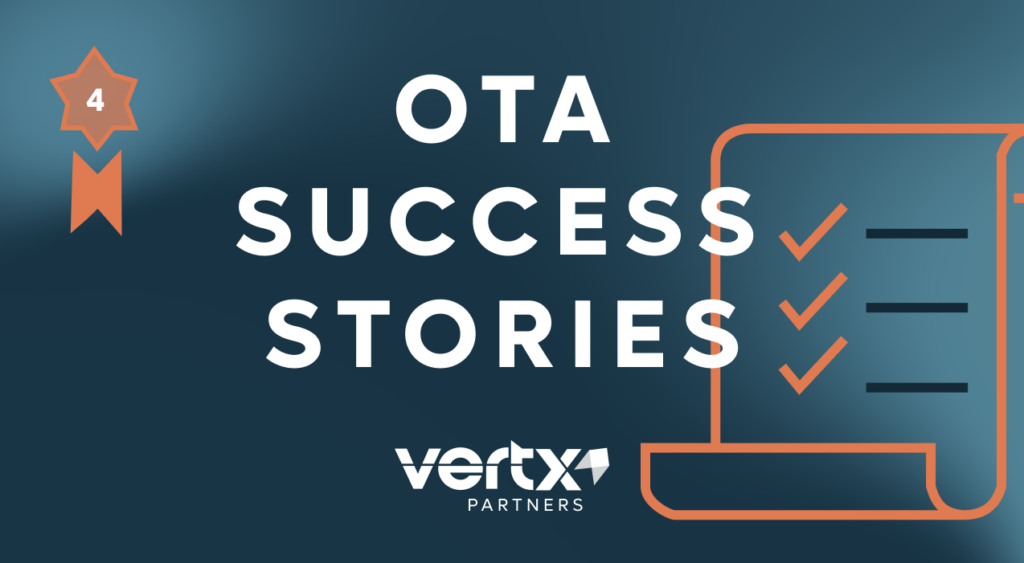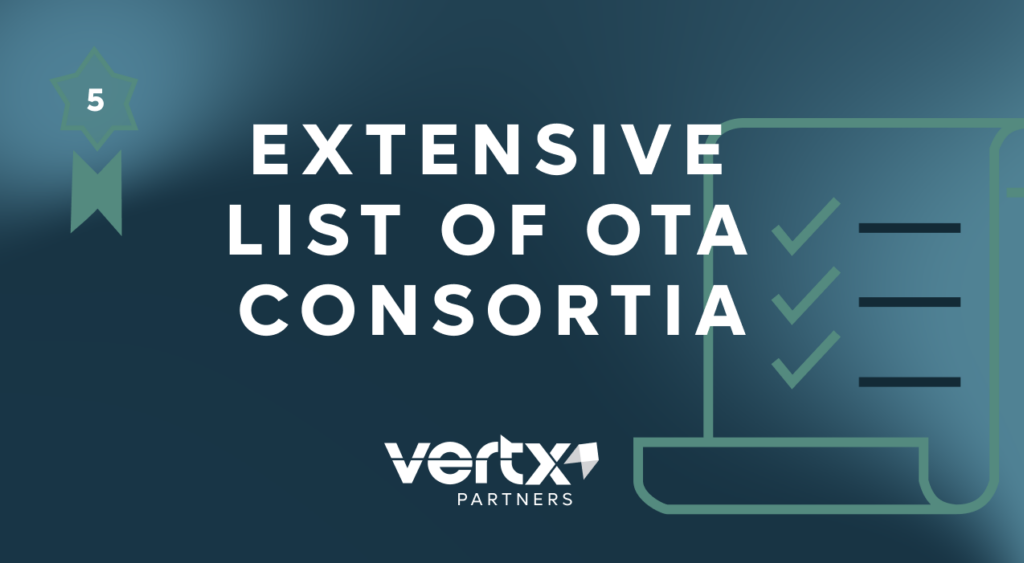This article is a hub to learn about the fundamentals of OTAs and OTA consortia, how they benefit your business, and whether you should pursue one.
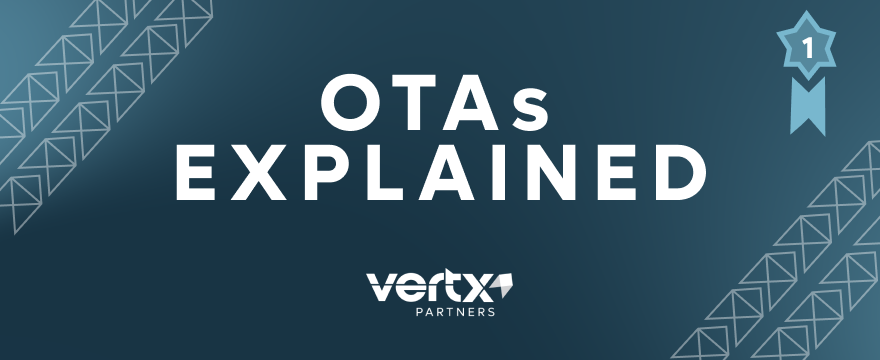
Other Transaction Authority (OTA) Resources
This is resource one of five from Vertx Partners available about OTAs. You can find the other resources, including a comprehensive list of all OT Consortia, below.
OTAs: Vertx Partners’ Next Step Towards Helping You Work with the Federal Government
For the past year and a half, we have focused primarily on highlighting the merits of the federal government’s Small Business Innovation Research (SBIR) and Small Business Technology Transfer (STTR) grants. These two premier contracting opportunities have changed the nature of the relationship between small businesses and the government. Along the way, we’ve showcased qualifying criteria, application procedures, limitations of the contracts, and a wealth of success stories of small, innovative companies striking gold with their ideas.
One aspect of this relationship we often harp on is its intractability. The world of federal contracting is difficult to manage for first-time small businesses looking to break into the sector. Many clients are hesitant to invest in the SBIR and/or STTR process due to the demands of time, education, etc.
Is there another option for small businesses?
Enter OTAs: Bringing Best Business Practices to the Federal Level
The Department of Defense (DoD) has what we call OTA: Other Transaction Authority. This authority grants them the ability to award OTAs: Other Transaction Agreements. A little confusing, but context helps sort the twin acronyms – still, what is Other Transaction Authority?
Described broadly, it’s the authority of the DoD to partner with small businesses to carry out particular research, prototype, and production projects. Sounds similar to the SBIR/STTR program, but with a crucial difference. OTA gives the DoD a malleability that allows it to adopt procedural processes reflecting current industry standards and best practices into the mechanism of this award.
This is a boon for small businesses.
Benefits of OTAs
Where preparation for SBIR/STTR standards involved coaching small businesses to meet the federal sphere where it’s at, OTA begins to bring the apparatus of the federal government into the realm of private practice. The Federal Acquisition Regulations (FAR) do not cover OTAs. This fact allows accommodation for small businesses at an unprecedented level.
This allows for:
- Quicker turn-around on new technology.
- Greater integration of non-traditional contractors/small businesses.
- Greater flexibility in contracting and payment agreements.
Let’s continue to dive deeper into OTAs.
The 3 Levels of OTAs
Much like the three phases of an SBIR/STTR grant, the feds split OTAs into three categories, sometimes progressing linearly.
- Research Purpose – These OTAs authorize the pursual of dual-use technology (tech with applications in the commercial and defense sectors) through basic, applied, and advanced research projects. These OTAs include a cost-sharing provision, oftentimes a 50/50 split, though this ratio is flexible given resource availability, prior engagement, risk assessment, etc.
- Prototype Purpose – These OTAs prioritize weapon/weapon system-based projects for the DoD to acquire and/or develop. The batch of prototypes* produced is limited, but this OTA provides a provision forward for a follow-on Production Purpose OTA without needing to recompete the effort. This provision is a game-changer for businesses awarded the Prototype Purpose OTA. However, they must take stock of the fact that they will need to organize a plan of acquisition and follow-on activities in the event of moving forward with a successful prototype.
- Production Purpose – This is a non-competitive, follow-on agreement moving forward from the Prototype Purpose OTA. Given sufficiently advanced consideration toward follow-on activity in the prototype phase and a clause referencing such, this contract will be awarded automatically.
(*Note: The statute gives no definition of ‘prototype’. It is typically defined as “a physical or virtual model used to evaluate the technical or manufacturing feasibility or military utility of a particular technology or process, concept, end item, or system.”)
To learn about the three levels of OTAs, check out our full guide on the topic here.
Who Awards OTAs?
Well, the federal government. Sometimes.
On rare occasions, OTAs are awarded directly from the DoD through a specially warranted Contracting Officer. More often than not, however, the federal government has instituted industry-specific middlemen called Other Transaction (OT) Consortia to distribute these awards more efficiently.
OT Consortia are split into three tiers: 1) the government sponsor, 2) the consortium manager, and 3) the body of the consortium itself.
Several government sponsors forgo the consortium manager altogether and manage the consortium in-house. For the sake of Vertx tradition, however, let’s consider the United States Air Force (USAF).
SOSSEC Case Study
Two bodies of the USAF, the Air Force Lifecycle Management Center (AFLCMC) and Air Force Research Laboratory (AFRL), do employ a consortium manager, SOSSEC, Inc. This manager runs SOSSEC (the Systems of Systems Consortium; easy enough). SOSSEC itself is made up of over 900 due-paying consortium members, each of whom belongs to an industry that SOSSEC specializes in. This specialization is, in turn, decided by its government sponsors.
AFRL, for example, holds two separate OTAs with SOSSEC, one described as a “coordinated prototyping and testing program […] that speeds the ability to rapidly prototype Government, industry, and academia capabilities in the areas of command, control, communications, computing, intelligence, surveillance, and reconnaissance (C4ISR) technologies.”
The other has a similar goal but accomplishes it through a non-Prototype Purpose OTA.
The body of any given consortium is made up of a diverse pool of entrants, all supporting a given technological domain (such as cyberspace, acoustics, propulsion, etc.):
- Traditional/non-traditional contractors
- Non-profit organizations
- Academic/research institutions
As you can imagine, joining a consortium has many benefits. These benefits include increased collaboration, reduced communication time, and shorter wait periods for award distribution. Many consortia distribute awards within three months of initiation.
View this comprehensive list of the consortia in your specific industry. View this guide to learn how to join an OT consortia.
How Much Authority is Entailed by OTA?
As mentioned, OTAs are not regulated by Federal Acquisition Regulations (FAR). This fact grants them greater flexibility than many similar small business federal contracts. Still, Other Transaction Authority is not total, and there are lines entities must color within.
Any given military branch has the authority to award up to $500 million per OTA. Beyond that, the federal government requires additional authorization. There is no limit to the aggregated amount awarded over time.
Awardee Criteria
This authority may be executed if one of the following criteria is met:
- The awardee is a non-traditional defense contractor OR small business:
- Non-Traditional Defense Contractor: “an entity that is not currently performing and has not performed, for at least the one-year period preceding the solicitation sources by the Department of Defense for the procurement or transaction, any contract or subcontract for the Department of Defense that is subject to the full coverage under the cost accounting standards prescribed pursuant to Section 1502 of title 41 and the regulations implementing such section.”
- Small Business: Generally, an independently owned for-profit enterprise that employs 500 or fewer persons. (Though there are exceptions depending on your industry. Some definitions put the cap at 1,500 employees and average annual receipts at $41.5 million. Visit SBA.gov for more info.)
- The awardee is a traditional defense contractor meeting one of the following criteria:
- At least one non-traditional contractor is contributing to a “significant” extent. While there is no statutory definition of this term, a “significant” contribution usually entails something like supplying a novel technology, process, application or providing for a material increase in efficiency or decrease of production cost.
- All “significant” participators are small businesses (with the exception of the federal government).
- A cost-sharing agreement is reached, typically requiring the contractor to cover 1/3 of the cost. However, this is subject to flexibility.
- The Service Acquisition Executive decides that special circumstances dictate the award of an OTA is more appropriate than a FAR-based contract.
Wrapping Up
Maybe by now, you’re beginning to get excited about the possibilities OTAs imply. With prototyping becoming DoD authorized in 2016, OTAs have steadily risen in popularity over the past half-decade, and there are various success stories from which to draw inspiration.
This article is designed to serve as a primer for understanding this burgeoning contracting opportunity. Vertx Partners continues to dedicate resources to educating and guiding our readers toward great economic opportunities, strengthening our nation’s defense, and proving Appalachia has what it takes to be an industrial powerhouse in the 21st century.
Like what you’ve read here today? Reach out to Vertx Partners on our contact page by filling out our six-minute survey letting us know about you and your business; a knowledgeable Vertx representative will be in touch ASAP.
Become an Innovator With Us
Tell us about yourself, answer a few questions, and hit submit. It’s as easy as that to get started.

